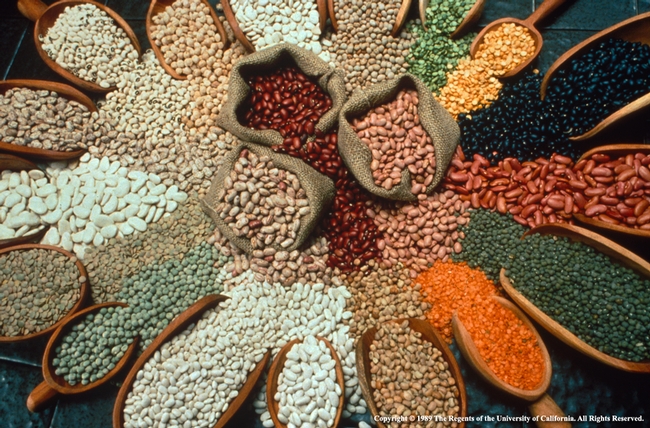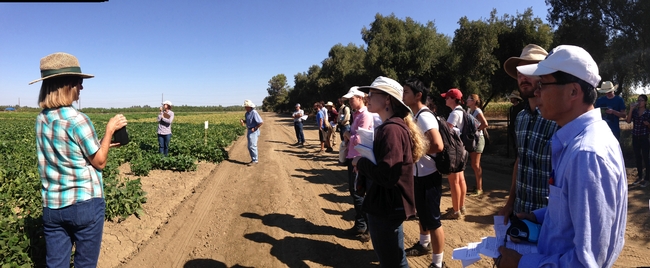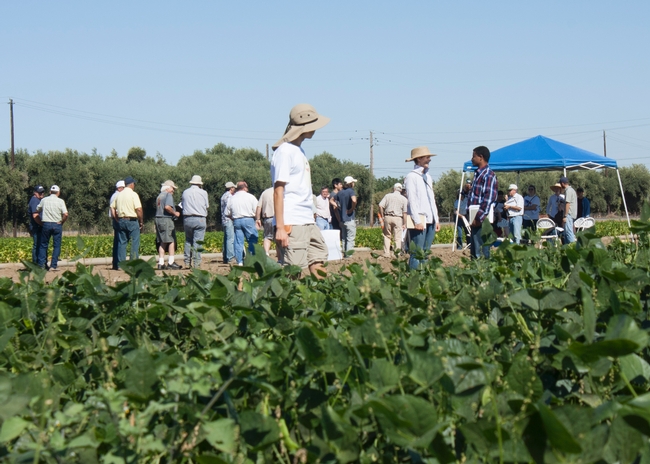UC variety research keeps California in lead for lima beans
California farmers grew about 23,000 acres of baby and large limas with a value of about $30 million in 2012, according to the National Agricultural Statistics Service.
“While that's not a lot compared to some crops in our state, it's significant because California growers produce 60 to 80 percent of the world's market of dry limas,” said Rachael Long, UC Cooperative Extension advisor.
The primary export market for California baby lima beans is Japan, where they are used to make Japanese confections, such as sweet bean filling for manju.
Dry lima beans, which are canned or packaged for domestic or export markets, are grown in California. Thick green lima beans for freezing are grown on the East Coast.
Among California lima beans, there are baby limas and large limas, and bush and vine types of both. Baby limas are grown primarily in the Sacramento Valley, while the large limas are grown south of Tracy and on the Central Coast. Large limas grown on the Central Coast are mostly dry farmed and used for canning.
“Baby limas are produced in the warmer areas north and south of the Bay Delta and large limas in the south Delta area, which has a slightly longer and drier harvest season and cooler night temperatures favoring flowering and pod filling,” she said. “So there's lots of baby limas in the Knights Landing area and large limas in the Patterson area.”
Farmers like to grow lima beans because they fix nitrogen, improve soil health, use relatively few pesticides and help control weeds in field crop rotations with crops including wheat, corn, tomatoes, alfalfa and sunflowers. Because lima beans are not a widely planted crop that would attract research investment by private companies, growers depend on UC research for improved varieties.
“Dr. Paul Gepts, along with Rachael Long and other researchers, plant extensive bean variety trials to select favorable genetics such as high yield, insect resistance and drought tolerance,” said lima grower Stephen Perez, who farms in Stanislaus County. “Their work is incredibly valuable to the California bean industry as well as to other bean growers around the world.”
“For years, we've been working on developing varieties of lima beans that are resistant to lygus bugs as well as nematodes, two significant pests of beans and limas in particular,” said Long. “These studies are mostly conducted by UC Davis professor Paul Gepts, UC Riverside professor Phil Roberts and UC Cooperative Extension farm advisors, continuing the research by now-retired UC Cooperative Extension specialist Steve Temple.”
Lygus bugs, which feed on buds and flowers, are very destructive to lima fields.
“With these new varieties, the use of pesticides has been decreased, saving growers unnecessary expenses and, just as important, reducing the use of these pesticides,” said Sano. “By using these lygus-resistant baby lima lines, Paul Gepts is now working on breeding that resistance into large lima varieties. This would provide those growers the same advantage.”
“We hope to identify the genetics of partial resistance, then we can select for resistance in crosses,” explained Gepts, professor in the Department of Plant Sciences at UC Davis. “We use a mix of basic and applied research in breeding, with a focus on developing new varieties.”
The UC scientists are also trying to breed lima bean plants that use less water. “We are trying to find how much we can reduce water and still get sufficient yields,” said Gepts. “Eventually we hope to test to identify markers for drought tolerance to lower the number of irrigations.”
Long and her colleagues recently published a lima bean production manual, which includes a list of large and baby lima varieties available in California and their pest-resistance levels. To help protect groundwater quality as required under new farm plans, the manual also features a table of nitrogen rates for lima production based on nitrogen levels in the soil and water. “Lima Bean Production in California” can be downloaded for free at http://anrcatalog.ucdavis.edu.
UC also has published cost of production studies for dry beans, including baby vine and bush types: "Sample Costs to Produce Beans-Common Dry Varieties-Double Cropped in the Sacramento Valley" and "Sample Costs to Produce Beans-Common Dry Varieties-Single Cropped in the Sacramento Valley." The production cost studies can be downloaded for free at http://coststudies.ucdavis.edu.
Comments:
Rachael Long, UC Cooperative Extension advisor, said, "I’m not sure, but try Ron Kelly in Sacramento, http://www.rkelleyfarms.net/
He’s a terrific resource."




Posted by Jo Ann Varelas on January 19, 2017 at 10:07 AM